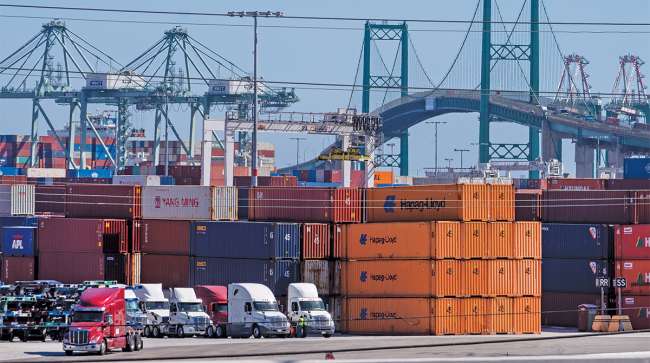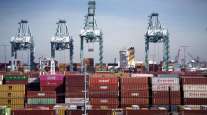Port of Los Angeles Imports Fell 4.5% in May

[Stay on top of transportation news: Get TTNews in your inbox.]
Imports at the Port of Los Angeles remained above the pre-pandemic peak in the first five months of 2024 despite ticking down in May compared to a year before.
“Cargo is down a little bit only because we had super big numbers a year ago,” Port of L.A. Executive Director Gene Seroka said at a press conference June 12.
The rush of cargo at this time last year came amid “rumblings” of a breaking point in contract talks between West Coast dockworkers and their employers, causing importers to bring goods in early, he said.
Overall container volumes at the busiest U.S. container port are up 18% in the first five months of the year compared to the same period in 2023.
May cargo volume strong, consistent: The Port of Los Angeles processed 752,893 Twenty-Foot Equivalent Units (TEUs) in May 2024. While that represents a slight 3% decline over last May, overall cargo volume remains 18% ahead of 2023 after five months. https://t.co/rWQZ3kcVuW pic.twitter.com/qWNK9KGiuk — Port of Los Angeles (@PortofLA) June 12, 2024
The Port of L.A. processed 390,663 20-foot-equivalent units of containerized imports last month compared to 409,150 the previous May, while empty containers were down almost 12%. The port handled 125,963 loaded export containers, up 23.8% from the same period last year.
Seroka said he expects the summer to continue to bring strong trade volumes to the port, because he hasn’t seen any weakening in purchase orders for manufacturing and retail sectors, or canceled sailings from Asia.
Risk looms in the global supply chain, however. Congestion along trade routes has caused spot freight rates to spike and talks between dockworkers at ports from Boston to Houston and their employers are shaping up to be increasingly difficult.
Seroka said cargo volumes at the Port of L.A. haven’t been affected much so far by disruptions like the attacks by Houthi militants on vessels in the Red Sea, or the International Longshoremen’s Association’s threat to strike if there’s no deal at the other ports by the Sept. 30 deadline.
“Folks on the import and export side have told me that they’ve shifted fractional amounts of their allocation to come over to Los Angeles as a hedge,” Seroka said. “Nothing huge, no big surge.”
Monthly inbound cargo volume at the nation’s major container ports is expected to reach its highest level in nearly two years this summer, according to the Global Port Tracker report released today by the National Retail Federation and Hackett Associates. https://t.co/ahLMgA9AV1 pic.twitter.com/CG2nGeQhhv — WWU Center for Economic and Business Research (@PugetSoundEF) June 11, 2024
At the same time, monthly imports to U.S. container ports are expected to reach the highest level in nearly two years this summer, according to a forecast from the National Retail Federation and Hackett Associates out earlier this week.
Council of Economic Advisers Chair Jared Bernstein, who joined the port’s press conference, said the White House was keeping a careful eye on the dockworker negotiations because of the potential impact on the economy, but they are doing so from a distance.
President Joe Biden “always supports collective bargaining but he also supports giving the parties the space they need when they’re at this stage of negotiation,” said Bernstein. “We’ve consistently made a point of staying out of their way and we encourage them to negotiate in good faith.”
Want more news? Listen to today's daily briefing below or go here for more info:




